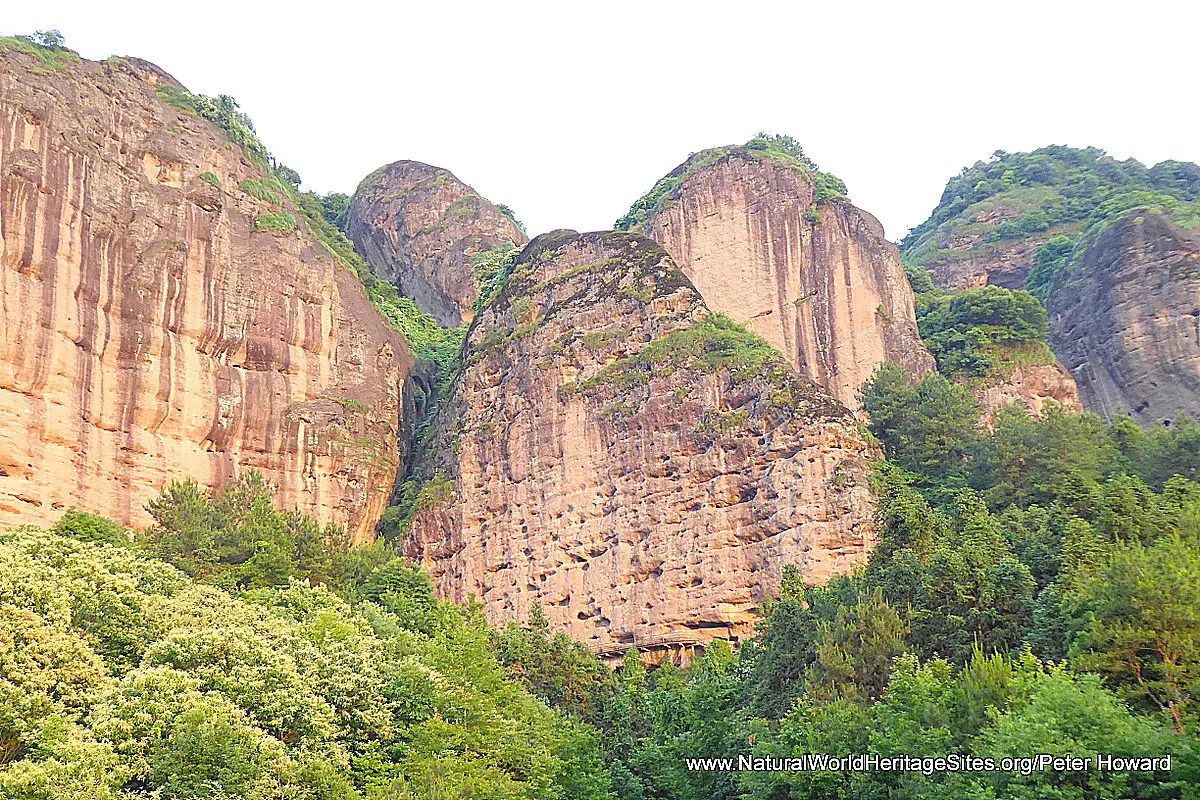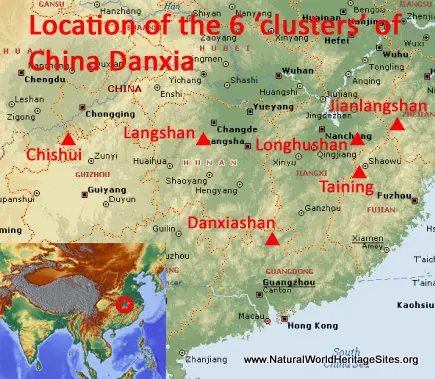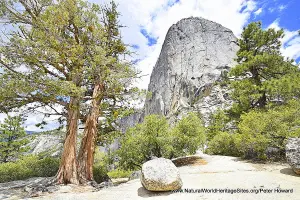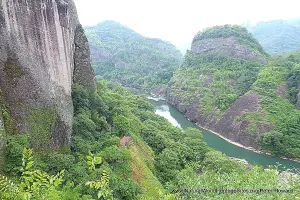EXPLORE THE CHINA DANXIA with this slideshow, check the location map and get all the facts and information below.
For slideshow description see right or scroll down (mobile). Click to view slideshow
Location and Values: The China Danxia site is spread across a large area of south-west China and includes six exemplary locations where spectacular red sandstone and conglomerate cliffs occur together with associated rock formations. The landscapes are spectacular, with massive cliffs, pillars, gorges, caves and arches created through the processes of uplift and subsequent erosion. The spectacular geological features are set in a humid sub-tropical environment of deep forests, punctuated with waterfalls and meandering rivers. With nine separate components in six ‘clusters’, each of the individual sites demonstrates unique features of this type of landscape.
Conservation Status and Prospects. According to IUCN’s Conservation Outlook Assessment (2014) the conservation status of the China Danxia site is ‘good’. The IUCN report notes that ‘The serial nature of the property, with its six widely separated component parts, is complex but the authorities must be commended on the degree to which they have provided a uniformly consistent legal and institutional framework for protection and management. Existing staff and other management resources appear to be adequate in coping with current factors affecting the property and low levels of threat. Protection of the property is assisted by its remoteness from development and the robust character of the geological landscape. There is a need to ensure protection of the natural forest vegetation and biodiversity, which contribute significantly to the scenic and aesthetic qualities and to the on-going land forming processes. There is a need to be vigilant in the face of an inevitable increase in visitor numbers and tourism development, and astute management intervention will be required to avoid any undesirable impacts of mass tourism. Among the most important challenges for the authorities is to increase the level of international understanding of the Danxia geological landscape, through increased collaborative research and scientific publication and wider promotion campaigns.’
Links:
Google Earth
Official UNESCO Site Details
IUCN Conservation Outlook
UNEP-WCMC Site Description
Slideshow description
The photos in this slideshow illustrate some of the features of the China Danxia at Longhushan, one of the six component ‘clusters’, lying in Jiangxi province. (The other components are not illustrated here but include Chishui, Taining, Langshan, Danxiashan and Jianglangshan, spread across the southern Chinese provinces of Guizhou, Hunan, Guangdong, Fujian and Zhejiang in a broad arc spanning a distance of some 1,700 km). The Longhushan ‘cluster’ comprises two separate ‘scenic areas’ linked within a ‘buffer zone’. The photos show the range of geological features and landscapes typical of the larger, western area which is inclined from south to north. In the far south, the Luxi River tributaries cascade through the higher mountains before meandering through the ‘middle reaches’ of the site and northwards towards the wider flat floodplain areas in the north. The ‘middle reaches’ of the river are characterized by the most spectacular scenery, with high peaks and massive cliffs on either side of the river. This area is most accessible to visitors and is the primary focus of the slideshow. The Longhushan site is an excellent example of Danxia landforms because it includes the range of features typical of ‘least eroded’ to ‘most eroded’ areas with the higher (southern) mountains being ‘young’ landscapes that have not been subjected to prolonged erosion, while the middle reaches illustrate a ‘mature’ Danxia landscape and the northern areas are so thoroughly eroded that only a few ‘old age landscape’ pinnacles, towers and smaller isolated hills rise above the floodplains.
Factfile
Website Category: Earth Features
Area: 821 km2
Inscribed: 2010
Criteria:
- Outstanding natural beauty (vii);
- Geological features (viii)





